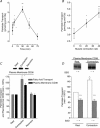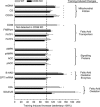Exercise- and training-induced upregulation of skeletal muscle fatty acid oxidation are not solely dependent on mitochondrial machinery and biogenesis
- PMID: 22890711
- PMCID: PMC3784190
- DOI: 10.1113/jphysiol.2012.238451
Exercise- and training-induced upregulation of skeletal muscle fatty acid oxidation are not solely dependent on mitochondrial machinery and biogenesis
Abstract
Regulation of skeletal muscle fatty acid oxidation (FAO) and adaptation to exercise training have long been thought to depend on delivery of fatty acids (FAs) to muscle, their diffusion into muscle, and muscle mitochondrial content and biochemical machinery. However, FA entry into muscle occurs via a regulatable, protein-mediated mechanism, involving several transport proteins. Among these CD36 is key. Muscle contraction and pharmacological agents induce CD36 to translocate to the cell surface, a response that regulates FA transport, and hence FAO. In exercising CD36 KO mice, exercise duration (-44%), and FA transport (-41%) and oxidation (-37%) are comparably impaired, while carbohydrate metabolism is augmented. In trained CD36 KO mice, training-induced upregulation of FAO is not observed, despite normal training-induced increases in mitochondrial density and enzymes. Transfecting CD36 into sedentary WT muscle (+41%), comparable to training-induced CD36 increases (+44%) in WT muscle, markedly upregulates FAO to rates observed in trained WT mice, but without any changes in mitochondrial density and enzymes. Evidently, in vivo CD36-mediated FA transport is key for muscle fuel selection and training-induced FAO upregulation, independent of mitochondrial adaptations. This CD36 molecular mechanism challenges the view that skeletal muscle FAO is solely regulated by muscle mitochondrial content and machinery.
Figures








References
-
- Abumrad NA, El-Maghrabi MR, Amri E-Z, Lopez E, Grimaldi P. Cloning of a rat adipocyte membrane protein implicated in binding or transport of long chain fatty acids that is induced during preadipocyte differentiation. Homology with human CD36. J Biol Chem. 1993;268:17665–17668. - PubMed
-
- Aoi W, Naito Y, Takanami Y, Ishii T, Kawai Y, Akagiri S, Kato Y, Osawa T, Yoshikawa T. Astaxanthin improves muscle lipid metabolism in exercise via inhibitory effect of oxidative CPT I modification. Biochem Biophys Res Commun. 2008;366:892–897. - PubMed
-
- Benton CR, Holloway GP, Han XX, Yoshida Y, Snook LA, Lally J, Glatz JF, Luiken JJ, Chabowski A, Bonen A. Increased levels of peroxisome proliferator-activated receptor gamma, coactivator 1 alpha (PGC-1α) improve lipid utilisation, insulin signalling and glucose transport in skeletal muscle of lean and insulin-resistant obese Zucker rats. Diabetologia. 2010;53:2008–2019. - PubMed
-
- Benton CR, Nickerson J, Lally J, Han X-X, Holloway GP, Glatz JFC, Luiken JJFP, Graham TE, Heikkila JJ, Bonen A. Modest PGC-1α overexpression in muscle in vivo is sufficient to increase insulin sensitivity and palmitate oxidation in SS, not IMF, mitochondria. J Biol Chem. 2008;283:4228–4240. - PubMed
-
- Bergstrom J, Hermansen L, Hultman E, Saltin B. Diet, muscle glycogen and physical performance. Acta Physiol Scand. 1967;71:140–150. - PubMed
Publication types
MeSH terms
Substances
Grants and funding
LinkOut - more resources
Full Text Sources
Medical
Molecular Biology Databases
Research Materials
Miscellaneous

